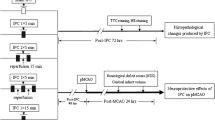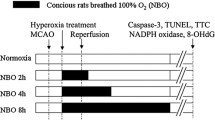Abstract
The purpose of this study was to determine whether the antibiotic erythromycin induces tolerance against focal cerebral ischemia, and the possible underlying mechanism including the involvement of neuronal nitric oxide synthase (nNOS) and hypoxia-inducible factor-1α (HIF-1α). In rat focal cerebral ischemia models, we found that erythromycin preconditioning could significantly decrease the cerebral infarct volume and brain edema. Meanwhile, the neurological deficits from day 4 through 7 after surgery were also remarkably decreased after erythromycin preconditioning. Moreover, erythromycin preconditioning induced significantly increased nNOS levels and decreased HIF-1α levels in both mRNA and protein expression. This study for the first time indicated that erythromycin preconditioning could induce focal brain ischemic tolerance and attenuate brain injury of subsequent transient focal cerebral ischemia. The potential mechanism may be due to up-regulation of nNOS, but the HIF-1α system was not involved.





Similar content being viewed by others
References
Shamloo M, Wieloch T (1999) Changes in protein tyrosine phosphorylation in the rat brain after cerebral ischemia in a model of ischemic tolerance. J Cereb Blood Flow Metab 19(2):173–183
Chang S, Jiang X, Zhao C, Lee C, Ferriero DM (2008) Exogenous low dose hydrogen peroxide increases hypoxia-inducible factor-1alpha protein expression and induces preconditioning protection against ischemia in primary cortical neurons. Neurosci Lett 441(1):134–138
Xiao-qian LIU, Rui SHENG, Zheng-hong QIN (2009) The neuroprotective mechanism of brain ischemic preconditioning. Acta Pharmacol Sin 30:1071–1080
Atochin DN, Clark J, Demchenko IT, Moskowitz MA, Huang PL (2003) Rapid cerebral ischemic preconditioning in mice deficient in endothelial and neuronal nitric oxide synthases. Stroke 34(5):1299–1303
Xu Q, Tang B, Zhang N, Song L, Zhang Z, Chen Y (2008) COX-2 or nNOS mediates cardioprotection during the final stage of the late phase of ischemic preconditioning. Sheng Wu Yi Xue Gong Cheng Xue Za Zhi 25(6):1411–1414
Feng RF, Hu YY, Li WB, Liu HQ, Li QJ, Zhang M (2009) The role of NO resulted from neuronal nitric oxide synthase in the metabotropic glutamate receptor2/3 mediated-brain ischemic tolerance. Zhongguo Ying Yong Sheng Li Xue Za Zhi 25(2):182–185
Mahfoudh-Boussaid A, Zaouali MA, Hadj-Ayed K, Miled AH, Saidane-Mosbahi D, Rosello-Catafau J, Ben Abdennebi H (2012) Ischemic preconditioning reduces endoplasmic reticulum stress and up-regulates hypoxia inducible factor-1α in ischemic kidney: the role of nitric oxide. J Biomed Sci 19:7
Bergeron M, Gidday JM, Yu AY, Semenza GL, Ferriero DM, Sharp FR (2000) Role of hypoxia-inducible factor-1 in hypoxia-induced ischemic tolerance in neonatal rat brain. Ann Neurol 48:285–296
Suzuki H, Tomida A, Tsuruo T (2001) Dephosphorylated hypoxia-inducible factor 1alpha as a mediator of p53-dependent apoptosis during hypoxia. Oncogene 20(41):5779–5788
Brambrink AM, Koerner IP, Diehl K, Strobel G, Noppens R, Kempski O (2006) The antibiotic erythromycin induces tolerance against transient global cerebral ischemia in rats (pharmacologic preconditioning). Anesthesiology 104(6):1208–1215
Koerner IP, Gatting M, Noppens R, Kempski O, Brambrink AM (2007) Induction of cerebral ischemic tolerance by erythromycin preconditioning reprograms the transcriptional response to ischemia and suppresses inflammation. Anesthesiology 106(3):538–547
Longa EZ, Weinstein PR, Carlson S, Cummins R (1989) Reversible middle cerebral artery occlusion without craniectomy in rats. Stroke 20(1):84–91
Shimakura A, Kamanaka Y, Ikeda Y, Kondo K, Suzuki Y, Umemura K (2000) Neutrophil elastase inhibition reduces cerebral ischemic damage in the middle cerebral artery occlusion. Brain Res 858(1):55–60
Chen H, Xing B, Liu X, Zhan B, Zhou J, Zhu H, Chen Z (2008) Similarities between ozone oxidative preconditioning and ischemic preconditioning in renal ischemia/reperfusion injury. Arch Med Res 39(2):169–178
Nandagopal K, Dawson TM, Dawson VL (2001) Critical role for nitric oxide signaling in cardiac and neuronal ischemic preconditioning and tolerance. J Pharmacol Exp Ther 297(2):474–478
Lu XM, Zhang GX, Yu YQ, Kimura S, Nishiyama A, Matsuyoshi H, Shimizu J, Takaki M (2009) The opposite roles of nNOS in cardiac ischemia-reperfusion-induced injury and in ischemia preconditioning-induced cardioprotection in mice. J Physiol Sci 59(4):253–262
Andoh T, Chock PB, Chiueh CC (2002) Preconditioning-mediated neuroprotection: role of nitric oxide, cGMP, and new protein expression. Ann NY Acad Sci 962:1–7
Scorziello A, Santillo M, Adornetto A, Dell’aversano C, Sirabella R, Damiano S, Canzoniero LM, Renzo GF, Annunziato L (2007) NO-induced neuroprotection in ischemic preconditioning stimulates mitochondrial Mn-SOD activity and expression via Ras/ERK1/2 pathway. J Neurochem 103(4):1472–1480
Kapinya KJ, Lowl D, Futterer C, Maurer M, Waschke KF, Isaev NK, Dirnagl U (2002) Tolerance against ischemic neuronal injury can be induced by volatile anesthetics and is inducible NO synthase dependent. Stroke 33:1889–1898
Cho S, Park EM, Zhou P, Frys K, Ross ME, Iadecola C (2005) Obligatory role of inducible nitric oxide synthase in ischemic preconditioning. J Cereb Blood Flow Metab 25:493–501
Kawano T, Kunz A, Abe T, Girouard H, Anrather J, Zhou P, Iadecola C (2007) iNOS-derived NO and nox2-derived superoxide confer tolerance to excitotoxic brain injury through peroxynitrite. J Cereb Blood Flow Metab 27(8):1453–1462
Cai Z, Zhong H, Bosch-Marce M, Fox-Talbot K, Wang L, Wei C, Trush MA, Semenza GL (2008) Complete loss of ischaemic preconditioning-induced cardioprotection in mice with partial deficiency of HIF-1 alpha. Cardiovasc Res 77(3):463–470
Knudsen AR, Kannerup AS, Grønbæk H, Andersen KJ, Funch-Jensen P, Frystyk J, Flyvbjerg A, Mortensen FV (2011) Effects of ischemic pre- and postconditioning on HIF-1α, VEGF and TGF-β expression after warm ischemia and reperfusion in the rat liver. Comp Hepatol 10(1):3
Sarkar K, Cai Z, Gupta R, Parajuli N, Fox-Talbot K, Darshan MS, Gonzalez FJ, Semenza GL (2012) Hypoxia-inducible factor 1 transcriptional activity in endothelial cells is required for acute phase cardioprotection induced by ischemic preconditioning. Proc Natl Acad Sci USA 109(26):10504–10509
Kalakech H, Tamareille S, Pons S, Godin-Ribuot D, Carmeliet P, Furber A, Martin V, Berdeaux A, Ghaleh B, Prunier F (2013) Role of hypoxia inducible factor-1α in remote limb ischemic preconditioning. J Mol Cell Cardiol S0022–2828(13):00292–00297
Schölzke MN, Schwaninger M (2007) Transcriptional regulation of neurogenesis: potential mechanisms in cerebral ischemia. J Mol Med 85:577–588
Tang B, Qu Y, Wang D, Mu D (2010) Targeting hypoxia inducible factor-1α: a novel mechanism of ginsenoside rg1 for brain repair after hypoxia/ischemia brain damage. CNS Neurol Disord Drug Targets 10:235–238
Knudsen AR, Kannerup AS, Grønbæk H, Andersen KJ, Funch-Jensen P, Frystyk J, Flyvbjerg A, Mortensen FV (2011) Effects of ischemic pre- and postconditioning on HIF-1α, VEGF and TGF-β expression after warm ischemia and reperfusion in the rat liver. Comp Hepatol 10(1):3
Acknowledgments
This work was supported by grants from the National Natural Science Foundation of China (No. 30400463), the Natural Science Foundation of Liaoning Province (No. 20072099, No. 2013021075), and Technology Plan Project of Educational Department of Liaoning Province (No. 2006401013-3), Science and Technology Plan Project of Liaoning Province (No. 2012225070, No. 20131114).
Conflict of interest
The authors declare that there are no conflicts of interest.
Author information
Authors and Affiliations
Corresponding author
Additional information
W. Lu and G. Li are the first two authors who contributed equally to this work.
Rights and permissions
About this article
Cite this article
Lu, Wc., Li, Gy., Xie, H. et al. Erythromycin pretreatment induces tolerance against focal cerebral ischemia through up-regulation of nNOS but not down-regulation of HIF-1α in rats. Neurol Sci 35, 687–693 (2014). https://doi.org/10.1007/s10072-013-1584-5
Received:
Accepted:
Published:
Issue Date:
DOI: https://doi.org/10.1007/s10072-013-1584-5




